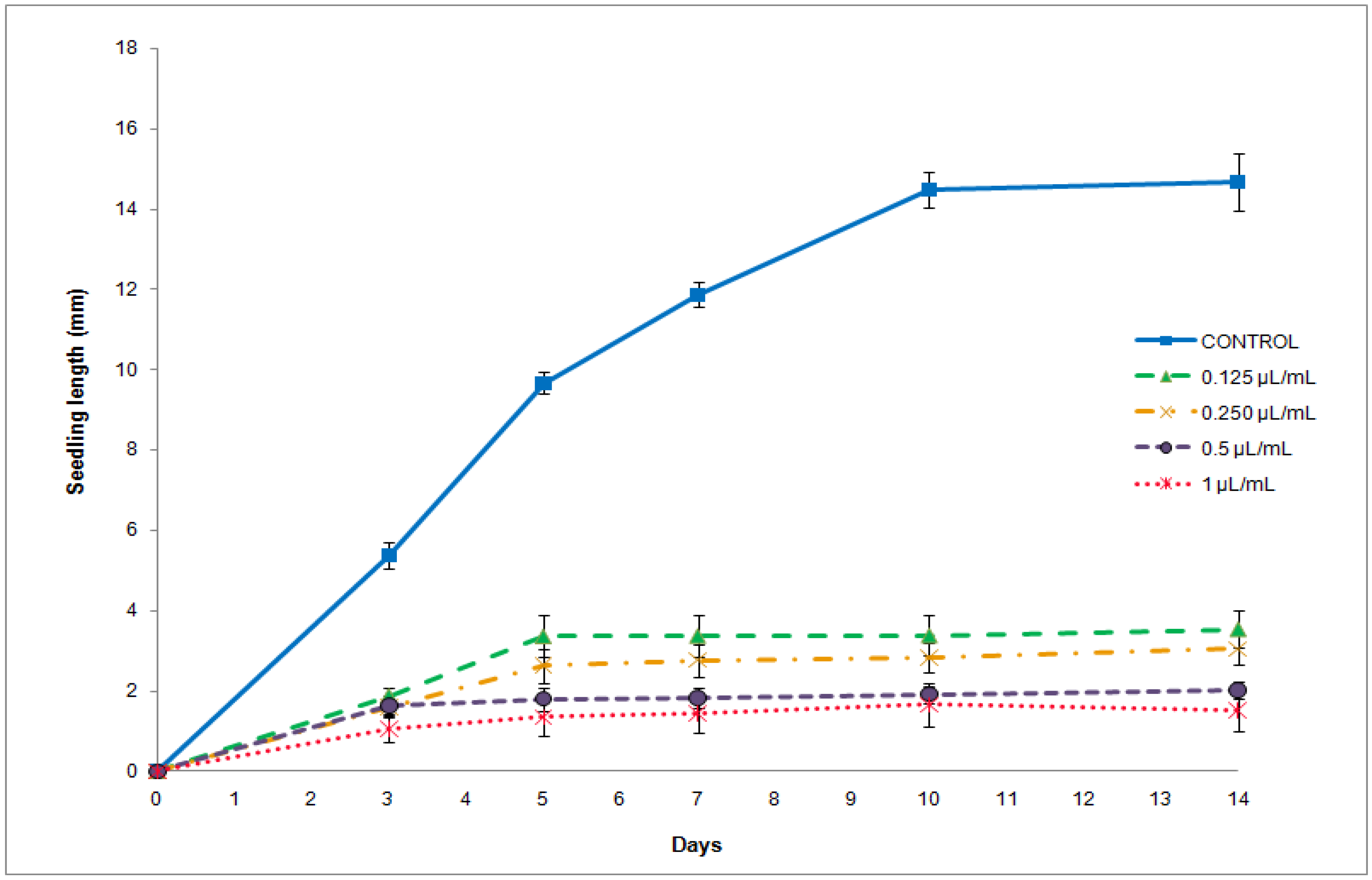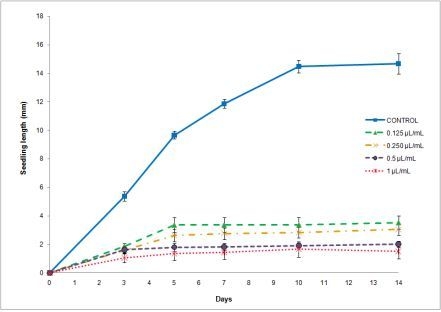Herbicidal Activity of Peumus boldus and Drimys winterii Essential Oils from Chile
Abstract
:1. Introduction
2. Results and Discussion
| Compound | RI | Peumus boldus (mean ± s.e.) | Drimys winterii (mean ± s.e.) |
| Monoterpene hydrocarbons | 19.71 ± 2.94 | 16.74 ± 2.43 | |
| α-thujene | 930 | - | 0.05 ± 0.02 |
| α-pinene | 939 | 0.27 ± 0.04 | 0.93 ± 0.23 |
| camphene | 952 | 0.11 ± 0.01 | - |
| sabinene | 976 | 1.20 ± 0.25 | 2.97 ± 0.68 |
| β-pinene | 979 | 0.18 ± 0.02 | 2.68 ± 0.58 |
| myrcene | 991 | - | 0.99 ± 0.15 |
| α-phelladrene | 1005 | t | 0.25 ± 0.09 |
| δ-3-carene | 1011 | t | - |
| α-terpinene | 1019 | 0.30 ± 0.03 | 1.70 ± 0.19 |
| p-cymene | 1027 | 16.31 ± 2.52 | 0.05 ± 0.02 |
| limonene | 1032 | - | 2.46 ± 0.48 |
| β-phellandrene | 1033 | 0.31 ± 0.13 | - |
| cis-ocimene | 1042 | - | 0.47 ± 0.05 |
| γ-terpinene | 1062 | 0.42 ± 0.00 | 3.30 ± 0.20 |
| terpinolene | 1089 | - | 0.91 ± 0.04 |
| p-cymenene | 1090 | t | - |
| 1.3.8-p-menthatriene | 1112 | 0.64 ± 0.29 | - |
| Oxygenated monoterpenes | 74.77 ± 4.26 | 13.95 ± 1.23 | |
| dehydro-1,8-cineole | 992 | 0.09 ± 0.02 | - |
| 1,8-cineole | 1034 | 14.45 ± 2.99 | 0.13 ± 0.01 |
| cis-sabinene hydrate | 1070 | 0.56 ± 0.28 | t |
| fenchone | 1088 | t | - |
| trans-sabinene hydrate | 1097 | 0.51 ± 0.19 | t |
| linalool | 1100 | t | 0.07 ± 0.01 |
| dehydro-sabina ketone | 1121 | 0.83 ± 0.23 | - |
| cis-p-menth-2-en-1-ol | 1122 | - | t |
| trans-pinocarveol | 1140 | 1.50 ± 0.26 | - |
| trans-p-menth-2-en-1-ol | 1141 | - | 0.44 ± 0.06 |
| camphor | 1146 | 0.13 ± 0.02 | - |
| sabina ketone | 1160 | t | - |
| pinocarvone | 1169 | 0.30 ± 0.11 | - |
| δ-terpineol | 1169 | 0.64 ± 0.11 | - |
| terpinen-4-ol | 1179 | 2.15 ± 0.33 | 11.56 ± 1.06 |
| thuj-3-en-10-al | 1185 | t | - |
| cryptone | 1186 | t | - |
| α-terpineol | 1191 | 0.06 ± 0.01 | 1.61 ± 0.11 |
| myrtenal | 1195 | 0.09 ± 0.03 | - |
| cis-piperitol | 1196 | - | t |
| myrtenol | 1197 | 1.11 ± 1.33 | - |
| trans- piperitol | 1207 | - | 0.14 ± 0.01 |
| ascaridole | 1242 | 51.17 ± 9.51 | - |
| cis-piperitone epoxide | 1259 | 0.76 ± 0.20 | - |
| trans-piperitone epoxide | 1262 | t | - |
| bornyl acetate | 1288 | 0.08 ± 0.01 | - |
| thymol | 1293 | 0.06 ± 0.01 | - |
| p-cymen-7-ol | 1295 | 0.12 ± 0.02 | - |
| carvacrol | 1302 | 0.24 ± 0.15 | - |
| Sesquiterpene hydrocarbons | - | 2.89 ± 0.18 | |
| β-elemene | 1392 | - | 0.14 ± 0.02 |
| α-cedrene | 1411 | - | 0.30 ± 0.04 |
| β-caryophyllene | 1419 | - | 0.19 ± 0.00 |
| trans-β-farnesene | 1459 | - | 0.15 ± 0.04 |
| α-acoradiene | 1465 | - | t |
| γ-curcumene | 1481 | - | 1.91 ± 0.14 |
| α-curcumene | 1484 | - | 0.17 ± 0.03 |
| bicyclogermacrene | 1496 | - | 0.04 ± 0.01 |
| Oxygenated sesquiterpenes | 0.27 ± 0.05 | 57.82 ± 1.38 | |
| 4-epi-cis-dihydroagarofuran | 1499 | - | 0.34 ± 0.02 |
| italicene ether | 1536 | - | 0.12 ± 0.01 |
| elemol | 1555 | - | 12.03 ± 0.34 |
| E-nerolidol | 1566 | - | 0.36 ± 0.01 |
| spathulenol | 1578 | 0.12 ± 0.03 | t |
| rosifoliol | 1602 | - | 0.08 ± 0.00 |
| 5-epi-7-epi-α-eudesmol | 1607 | t | |
| β-oplopenone | 1609 | 0.15 ± 0.02 | - |
| epi-cedrol | 1614 | - | 0.75 ± 0.01 |
| 10-epi-γ-eudesmol | 1621 | - | 1.86 ± 0.06 |
| γ-eudesmol | 1639 | - | 21.65 ± 0.41 |
| β-eudesmol | 1656 | - | 7.27 ± 0.35 |
| α-eudesmol | 1659 | - | 7.35 ± 0.14 |
| 7-epi-α-eudesmol | 1662 | - | 0.12 ± 0.04 |
| β-bisabolol | 1674 | - | 4.61 ± 0.22 |
| α-bisabolol | 1687 | - | 0.07 ± 0.02 |
| drimenol | 1763 | - | 1.18 ± 0.04 |
| drimenin | 1951 | - | 0.06 ± 0.01 |
| Aromatic compounds (C6-C3) | 1.20 ± 0.18 | 4.83 ± 0.42 | |
| safrole | 1287 | - | 0.09 ± 0.01 |
| eugenol | 1360 | - | 1.09 ± 0.10 |
| methyl eugenol | 1406 | 1.20 ± 0.18 | t |
| myristicin | 1522 | - | 3.66 ± 0.32 |
| elemicin | 1560 | - | t |
| Others | 0.34 ± 0.03 | t | |
| 3-octanol | 993 | - | t |
| 1.4-dione-2-cyclohexene | 1015 | 0.06 ± 0.01 | - |
| 2-nonanone | 1093 | 0.07 ± 0.00 | - |
| 3-octanol acetate | 1128 | - | t |
| 2-undecanone | 1295 | 0.24 ± 0.03 | - |
| TOTAL IDENTIFIED | 96.90 ± 1.06 | 96.24 ± 0.28 | |
| Treatment | Peumus boldus essential oil | Drimys winterii essential oil |
|---|---|---|
| CONTROL | 71.0 ± 2.9 a | 71.0 ± 2.9 ab |
| 0.125 µL/mL | 0.0 ± 0.0 b | 74.0 ± 5.8 a |
| 0.250 µL/mL | 0.0 ± 0.0 b | 53.0 ± 6.0 b |
| 0.5 µL/mL | 0.0 ± 0.0 b | 30.0 ± 6.1 c |
| 1 µL/mL | 0.0 ± 0.0 b | 27.5 ± 9.9 c |

3. Experimental
3.1. Plant material
3.2. Oil isolation
3.3. GC and GC-MS analyses
3.4. Biological assay
3.5. Statistical analyses
4. Conclusions
Acknowledgements
References
- Duke, S.O.; Romagni, J.G.; Dayan, F.E. Natural products as sources for new mechanisms of herbicidal action. Crop Prot. 2000, 19, 583–589. [Google Scholar] [CrossRef]
- Vyvyan, J.R. Allelochemicals as leads for new herbicides and agrochemicals. Tetrahedron 2002, 58, 1631–1636. [Google Scholar] [CrossRef]
- Tehmina, A.; Stevenson, P.; Hall, D.; Bajwa, R. Allelophatic potential of Helianthus annuus L. (sunflower) as natural herbicide. In “Establishing the Scientific Base”, Proceedings of the Fourth World Congress on Allelopathy, Charles Sturt University: Wagga Wagga, NSW, Australia, 21–26 August 2005.
- Speisky, H.; Cassel, B.K. Boldo and boldine: An emerging case of natural drug development. Pharmacol. Res. 1994, 29, 1–10. [Google Scholar] [CrossRef]
- Simirgiotis, M.J.; Schmeda-Hirschmann, G. Direct identification of phenolic constituents in Boldo Folium (Peumus boldus Mol.) infusions by high-performance liquid chromatography with diode array detection and electrospray ionization tandem mass spectrometry. J. Cromatogr. A 2010, 1217, 443–449. [Google Scholar] [CrossRef]
- Silva, E.; Jopia, M.; Edwards, A.M.; Lemp, E.; de la Fuente, J.R.; Lissi, E. Protective effect of boldo and tea infusions on the visible light-mediated pro-oxidant effects of vitamin B2, riboflavin. Photochem. Photobiol. 2002, 75, 585–590. [Google Scholar]
- Milián, L.; Estellés, R.; Abarca, B.; Ballesteros, R.; Sanz, M.J.; Blázquez, M.A. Reactive oxygen species (ROS) generation inhibited by aporphine and phenanthrene alkaloids semi-synthesized from natural boldine. Chem. Pharm. Bull. 2004, 52, 696–699. [Google Scholar] [CrossRef]
- Quezada, N.; Asencio, M.; Del Valle, J.M.; Aguilera, J.M.; Gómez, B. Antioxidant activity of crude extract, alkaloid fraction, and flavonoid fraction from Boldo (Peumus boldus Molina) leaves. J. Food Sci. 2004, 69, 371–376. [Google Scholar]
- Vila, R.; Valenzuela, L.; Bello, H.; Cañigueral, S.; Montes, M.; Adzet, T. Composition and antimicrobial activity of the essential oil of Peumus boldus leaves. Planta Med. 1999, 65, 178–179. [Google Scholar] [CrossRef]
- Bittner, M.; Aguilera, M.A.; Hernández, V.; Arbert, C.; Becerra, J.; Casanueva, E. Fungistatic activity of essential oils extracted from Peumus boldus Mol., Laureliopsis philippiana (Looser) Schodde and Laurelia sempervirens (Ruix y Pav.) Tul (Chilean Monimiaceae). Chilean J. Agric. Res. 2009, 69, 30–37. [Google Scholar]
- Muñoz-Concha, D.; Vogel, H.; Razmilic, I. Variación de compuestos químicos en hojas de poblaciones de Drimys ssp (Magnoliophyta: Winteraceae) en Chile. Rev. Chil. Hist. Nat. 2004, 77, 43–50. [Google Scholar]
- Verdeguer, M.; Blázquez, M.A.; Boira, H. Phytotoxic effects of Lantana camara, Eucalyptus camaldulensis and Eriocephalus africanus essential oils in weeds of Mediterranean summer crops. Biochem. Syst. Ecol. 2009, 37, 362–369. [Google Scholar] [CrossRef]
- Vokou, D.; Douvli, P.; Blionis, G.J.; Halley, J.M. Effects of monoterpenoids, acting alone or in pairs, on seed germination and subsequent seedling growth. J. Chem. Ecol. 2003, 29, 2281–2301. [Google Scholar] [CrossRef]
- Kotan, R.; Cakir, A.; Dadasoglu, F.; Aydin, T.; Cakmakci, R.; Ozer, H.; Kordali, S.; Mete, E.; Dikbas, N. Antibacterial activities of essential oils and extracts of Turkish Achillea, Satureja and Thymus species against plant pathogenic bacteria. J. Sci. Food Agric. 2010, 90, 145–160. [Google Scholar] [CrossRef]
- Rolim de Almeida, L.F.; Frei, F.; Mancini, E.; De Martino, L.; De Feo, V. Phytotoxic activities of Mediterranean essential oils. Molecules 2010, 15, 4309–4323. [Google Scholar] [CrossRef]
- Dudai, N.; Ben-Ami, M.; Chaimovich, R.; Chaimovitsh, D. Essential oils as allelopathic agents: bioconversion of monoterpenes by germinating wheat seeds. Acta Hort. 2004, 629, 505–508. [Google Scholar]
- Armirante, F.; De Falco, E.; De Feo, V.; De Martino, L.; Mancini, E.; Quarante, E. Allelopathic activity of essential oils from Mediterranean Labiatae. Acta Hort. 2006, 723, 347–352. [Google Scholar]
- Adams, R.P. Identification of Essential Oil Components by Gas Chromatography/Mass Spectrometry; Allured Publishing Corporation: Carol Stream, IL, USA, 2007. [Google Scholar]
- Sample Availability: Samples of the compounds are available from the authors.
© 2011 by the authors; licensee MDPI, Basel, Switzerland. This article is an open access article distributed under the terms and conditions of the Creative Commons Attribution license ( http://creativecommons.org/licenses/by/3.0/).
Share and Cite
Verdeguer, M.; García-Rellán, D.; Boira, H.; Pérez, E.; Gandolfo, S.; Blázquez, M.A. Herbicidal Activity of Peumus boldus and Drimys winterii Essential Oils from Chile. Molecules 2011, 16, 403-411. https://doi.org/10.3390/molecules16010403
Verdeguer M, García-Rellán D, Boira H, Pérez E, Gandolfo S, Blázquez MA. Herbicidal Activity of Peumus boldus and Drimys winterii Essential Oils from Chile. Molecules. 2011; 16(1):403-411. https://doi.org/10.3390/molecules16010403
Chicago/Turabian StyleVerdeguer, Mercedes, David García-Rellán, Herminio Boira, Eduardo Pérez, Sandra Gandolfo, and María Amparo Blázquez. 2011. "Herbicidal Activity of Peumus boldus and Drimys winterii Essential Oils from Chile" Molecules 16, no. 1: 403-411. https://doi.org/10.3390/molecules16010403
APA StyleVerdeguer, M., García-Rellán, D., Boira, H., Pérez, E., Gandolfo, S., & Blázquez, M. A. (2011). Herbicidal Activity of Peumus boldus and Drimys winterii Essential Oils from Chile. Molecules, 16(1), 403-411. https://doi.org/10.3390/molecules16010403








